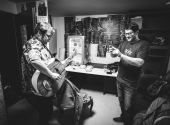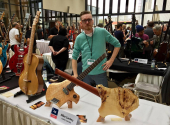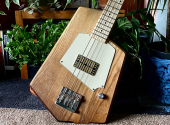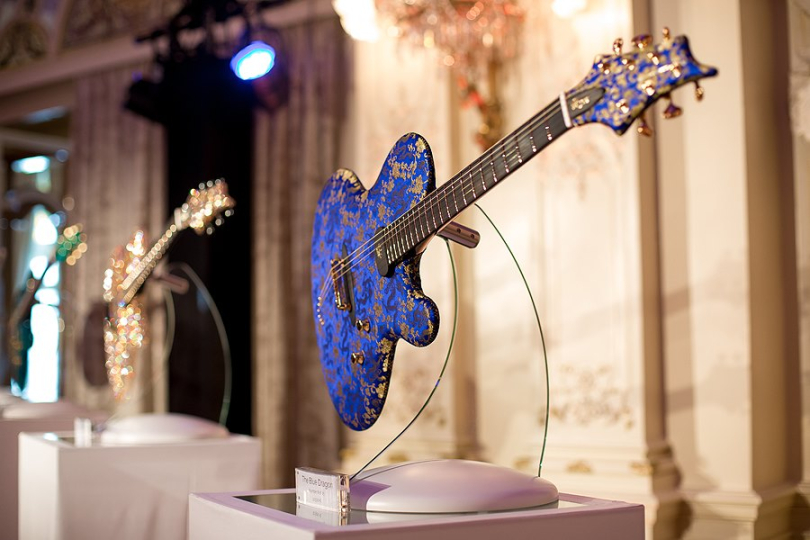
Dreamstruments #19: Jens Ritter Instruments
There are more than enough ways for guitar makers to become different from their competition nowadays. Some have honed to perfection what has already been invented, some have gone their own gait regardless of what is going on and others are able and willing to accommodate any customer request, whether it's a good idea or not. In this part of our Dreamstruments series, we follow the mark that German luthier Jens Ritter has made since the late 1990s. And it's not just any mark. Who else among independent guitar makers can say that their instruments have appeared in the hands of the most famous players but also in the world's leading galleries and museums as works of art on their own?
Jens Ritter's story starts out rather dull. Leaving aside the anecdote about his first instrument made at the age of seven, the history of the brand doesn't begin to be written until the mid-1990s when Jens made his first bass guitar. Why? Because the basses he played as a "youngster" didn't suit him. But what was already starting to show at that time was his unique vision.
"I just wasn't satisfied with the basses I had in my teenage years. Not really attractive shapes, bad sound, horrible playability... and I never had enough money to buy a good bass," Jens told Talkbass.com. The experience of his grandfather, a carpenter, certainly helped him in the beginning. Later on, Jens was able to benefit from his own technical education.

An auspicious beginning
When Jens Ritter made his first two basses in the mid-1990s, he decided to get feedback from the most qualified ones and showed his instruments to the editor of the Gitarre und Bass music magazine. Jens recalls that he was a bit offended at first when the editor brushed him off uttering, "Leave it here, I don't have time now." A couple of weeks later, he wrote a letter to Jens saying nothing more than, "They look good, they play well." The more surprised he was when he soon found a whole three-page spread in the magazine devoted to the works of "guitar maker Jens Ritter" – and orders started coming in.

In the second half of the 90s, Jens started figuring it out. Although at the beginning he stuck to the phrase "better to steal well than to invent badly" and, as he admits, his first "original" shape was influenced by Carl Thompson's instruments (these are the ones you may know well from the hands of Les Claypool of the Primus), he gradually let unleash his own unique ideas of what modern instruments should look like. His instruments are created as an image in the mind of an artist who then transfers them to paper. As Jens says, he always imagined the ideal shape of the instrument and was inspired by looking at other brands of basses. Most of his models are thus almost an exact manifestation of the original vision with only minimal changes.
The admirable, the remarkable and the weird
There's no accounting for taste. Everyone's threshold for conservatism is set differently, and what is one man's junk is another's exact match. And that's what the range of instruments you'll encounter in the Jens Ritter Instruments range relies on. Guitars have been added to the bass line-up that can compare to their "deep-sounding" cousins in terms of design. Here, too, is no room for compromise or concession from the artistic vision of the author.
Guitars from the Blue Dragon series, which are covered with brocade, or instruments from the Sandokan series, which, thanks to the body covered with about eleven thousand Swarovski crystals clearly prove that the limit in the construction of an instrument is only in the mind of the luthier (by the way, only Jens Ritter has an official license to use Swarovski crystals in the construction of instruments). "Accept no limits – don't care about existing laws. Designing weird body shapes; using strange materials to get new unknown sounds out of; checking out new building techniques to get better playability. Just free experimenting. To do whatever you like. It's an internal desire," Jens Ritter sums up his modus operandi.
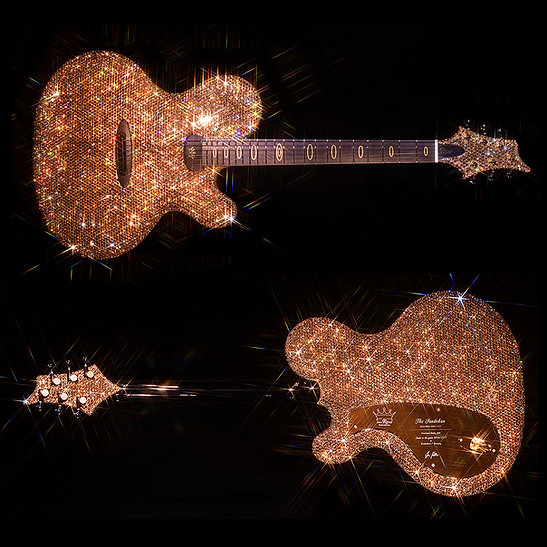
The anti-business approach and famous clients
Jens Ritter doesn't give interviews as often as one might expect. Maybe he doesn't have time or – and this is more likely – it doesn't fit the concept of his guitar making. "I cannot make a lot of money, I only make 80 instruments a year. If you want to make money, you have to make a production line. This is a totally different approach but I'm not interested in that. If I only wanted to make money, I'd become a banker or a lawyer. Instrument making for me is not a business. I don't like business, I have no passion for giving my life to work. I do exactly what I love and my passion has followers and they appreciate it," Jens summarizes in his profile for NAMM (although the number of instruments has now grown to one hundred and twenty instruments per year).
But Jens Ritter's instruments have found their way into the hands of many truly famous artists – from the vibrant Sandokan owned by Lady Gaga, through a Princess for jazz great George Benson to a six-string bass for Phil Lesh of the Grateful Dead... So Jens Ritter has more than enough high-profile customers. His instruments were also used by Prince, the well-known promoter of eccentric shapes, who was not only a universally acclaimed multi-instrumentalist but also did something that few can do: establish an eccentric instrument and "appropriate" it (whether we are talking about the Cloud Guitar or the Auerswald symbol).
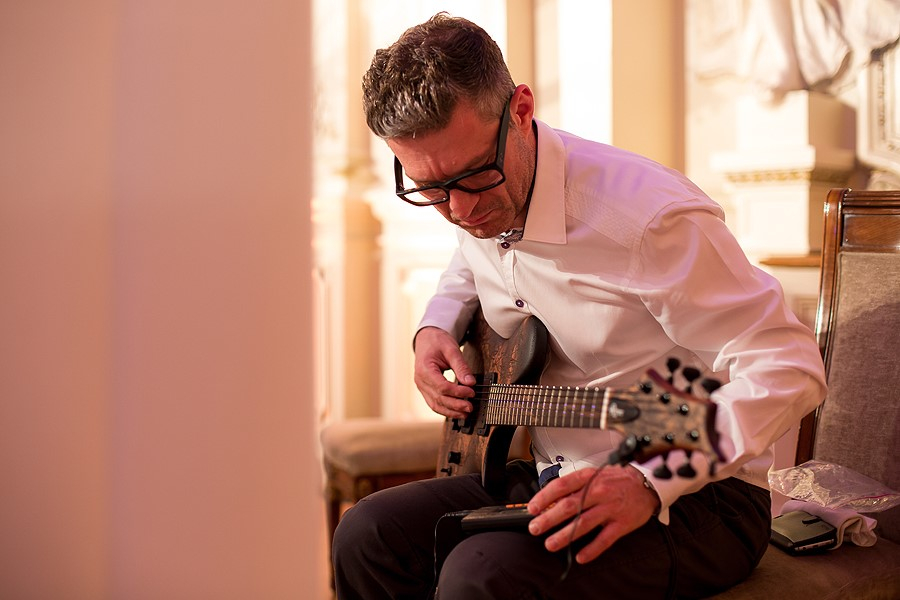
A musical instrument as a museum exhibit
By the way, if we mention the bass in the video above, i.e. Phil Lesh's instrument, it has to be said that this instrument now serves a completely different purpose. In fact, the bassist of the legendary Grateful Dead donated it to the Smithsonian Institution, a major museum in the USA. Not many people are that lucky to have their instrument exhibited there, especially if they are a living European.
Talking about a "museum" may give an impression (perhaps unfounded) of dusty exhibits and a display that has survived unchanged since the interwar period. But Jens Ritter's instruments don't quite fit such a picture. It is therefore not surprising that his instruments can also be found in The Metropolitan Museum Of Art in New York, the Museum Of Fine Arts in Boston and others.
Guitars for stratospheric prices
Jens Ritter builds instruments for the stars, instruments for museums, and even creates his own line of instruments that are perhaps intended as works of art rather than instruments. How else to explain the Intune Frames line which takes the concept of a guitar stand in reverse order, makes it a "stand"-alone piece of art and incorporates the guitar as its part?
After all of the above, it's no surprise that the contact page on Jens Ritter's website includes a link to the nearest private airport in addition to a questionnaire. His clientele is likely to belong to the sphere that might be interested in such information. It may be vulgar to discuss price (although the prices are right next to the instruments on Jens' website), but the fact is that the work of this unique guitar maker is simply beyond the financial realm of most musicians. But that, too, is part of the Dreamstruments – sometimes they are just unaffordable and so there is nothing to do but dream.
If you have found an error or typo in the article, please let us know by e-mail info@insounder.org.


